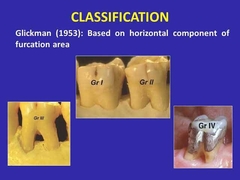![]()
![]()
![]()
Use LEFT and RIGHT arrow keys to navigate between flashcards;
Use UP and DOWN arrow keys to flip the card;
H to show hint;
A reads text to speech;
4 Cards in this Set
- Front
- Back
|
Definition |
The progress of inflammatory periodontal disease resulting in attachment loss sufficient enough to affect the bifurcation and trifurcation of multi rooted teeth. |
|
|
Etiology |
1. Local anatomical factors- Root trunk length , root morphology 2. Local developmental anomalies- Cervical Enamel Projections. 3. Age - Incidence and severity increase with age. 4. Endo- Caries and pulpal death. |
|
|
Classification |

Glickman-
Grade i- 1. Incipient or early stage. 2. Suprabony pocket 3. Early bone loss may have occurred with an increase in probing depth. 4. No evident radiographic changes.
Grade ii- 1. Cul de sac lesion with a definite horizontal component. 2. A portion of alveolar bone remains attached to the tooth. 3. Radiographic changes may or may not be visible. (Furcation arrows are visible in some views).
Grade iii 1. Bone is not attached to dome of furcation 2. Through and through involvement 3. May not be probed In such cases add buccal and lingual horizontal probing depths This must be greater than buccolingual dimension of tooth. 4. Radiographic changes- radiolucent area in the crotch of the tooth.
Grade iv- 1. Interdental bone is destroyed and soft tissue has receded apically 2. Clinically visible furcation opening 3. Probe easily passes. |
|
|
Therapeutic classification |

Study management of grade 2 in detail. |

